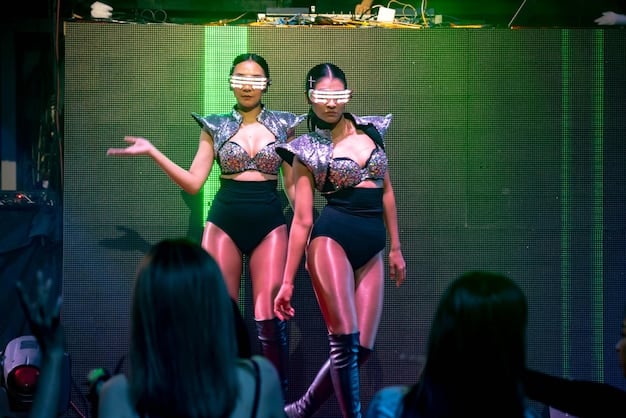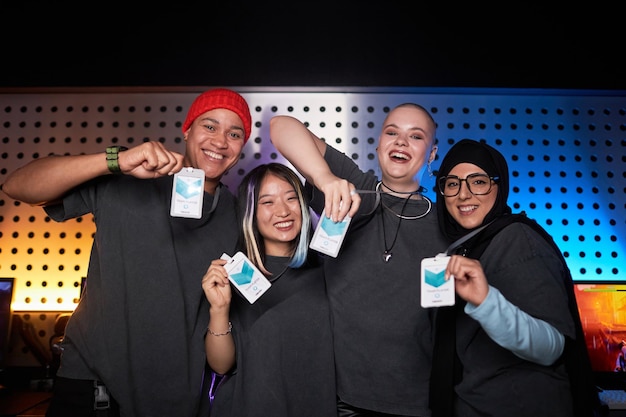K-Pop’s US Takeover: How Korean Culture Shapes American Pop Culture

The rise of K-pop in the US signifies a profound cultural shift, illustrating how Korean entertainment, fashion, and lifestyle are increasingly influencing American pop culture through global music, digital engagement, and an emphasis on authentic connections.
The global music scene has witnessed an undeniable seismic shift with the rise of K-Pop in the US: how Korean culture is influencing American pop culture. Once a niche genre, K-Pop has transcended geographical boundaries, becoming a dominant force not only in music but also in fashion, beauty, and even social dynamics across the United States. This phenomenon prompts a deeper investigation into the mechanisms behind its success and the broader implications for cultural exchange.
The Ascendancy of K-Pop: From Niche to Mainstream Sensation
The journey of K-Pop from an obscure genre a couple of decades ago to a global mainstream sensation, particularly in the United States, is a fascinating case study in cultural export. Its initial forays were met with curiosity, but through consistent innovation, strategic marketing, and an unparalleled connection with fans, K-Pop artists have carved out a significant space in the competitive American music landscape.
One of the primary drivers of K-Pop’s success has been its ability to offer a unique blend of music, visual aesthetics, and performance that often feels fresh and exciting compared to traditional Western pop. This distinctiveness has resonated deeply with American audiences seeking something new and different.
Redefining Music Consumption and Fan Engagement
K-Pop groups have pioneered new paradigms for music consumption and fan interaction, setting a benchmark for global entertainment industries. Their highly organized fan communities, often referred to as “fandoms,” are incredibly powerful, mobilizing for album sales, chart topping, and social media trends.
- Digital First Strategy: K-Pop embraced digital platforms early, leveraging YouTube, Twitter, and other social media to reach a global audience, bypassing traditional gatekeepers.
- Interactive Content: Beyond music videos, idols engage fans with behind-the-scenes content, reality shows, and live streams, fostering a deeper sense of connection.
- Fan Projects: Fandoms actively organize mass streaming events, bulk album purchases, and charity initiatives in their idols’ names, demonstrating immense collective power.
This intense level of fan engagement transforms passive listening into active participation, creating a powerful emotional bond between artists and their followers. It’s a model that many Western artists are now attempting to emulate, recognizing its efficacy in building loyalty and driving commercial success.
Visual Storytelling and Aesthetic Appeal: More Than Just Music
K-Pop’s allure extends far beyond its infectious melodies and slick production; it is a full sensory experience. The visual component is paramount, encompassing everything from intricate music video narratives to meticulously planned stage outfits and flawless choreography. This emphasis on aesthetics has profoundly influenced American pop culture’s visual sensibilities.
Music videos are often cinematic mini-movies, featuring stunning cinematography, elaborate sets, and compelling storylines. This commitment to high-quality visual storytelling ensures that K-Pop releases are not just heard but also seen and experienced on a profound level, leaving a lasting impression.
Fashion and Beauty Trends: From Seoul to the Streets of the US
The influence of K-Pop fashion and beauty has permeated American style, inspiring new trends in streetwear, makeup, and hair. K-Pop idols are fashion trendsetters, often seen wearing a mix of high-end designer brands and edgy streetwear, creating a unique, avant-garde aesthetic.
- Gender Fluidity in Fashion: K-Pop challenges traditional gender norms in fashion, often featuring male idols in skirts, makeup, and traditionally feminine silhouettes, promoting a more fluid approach to style.
- “Glass Skin” and Elaborate Makeup: The Korean beauty industry, championed by K-Pop idols, introduced America to multi-step skincare routines and sophisticated makeup techniques, like the “glass skin” trend.
- Unique Hair Colors and Styles: Idols frequently sport vibrant hair colors and experimental cuts, inspiring fans to be more daring with their personal grooming choices.
This influence highlights a growing openness in American culture to explore new forms of self-expression, moving beyond conventional standards of beauty and style. The visual artistry of K-Pop has undeniably expanded the visual vocabulary of American youth culture.
The Role of Social Media and Digital Platforms in K-Pop’s Expansion
In the digital age, the success of any global phenomenon is inextricably linked to its presence and strategy on social media and other digital platforms. K-Pop groups and their agencies understood this early, leveraging these tools not just for promotion but for direct, continuous engagement with their fanbases worldwide, including the significant American market.
Platforms like YouTube, Twitter, and TikTok have served as crucial conduits for K-Pop’s spread. They enable artists to release high-quality music videos instantly to a global audience, bypassing traditional media gatekeepers. This direct access fosters a sense of intimacy and immediacy that resonates deeply with younger audiences.
Fan Communities and Viral Content Creation
The collaborative nature of K-Pop fandoms on social media amplifies its reach. Fans actively participate in content creation, sharing, and translation, essentially becoming unpaid promoters for their favorite groups. This organic, grassroots marketing is incredibly powerful.
- Translation Efforts: Dedicated fans translate song lyrics, interviews, and social media posts, making content accessible to non-Korean speaking audiences and fostering deeper understanding.
- Dance Challenges: K-Pop choreography often inspires viral dance challenges on TikTok and Instagram, drawing in new fans through participatory trends.
- Hashtag Campaigns: Fandoms organize coordinated social media campaigns to trend hashtags, promote new releases, and defend their idols against criticism, showcasing immense collective power.
This decentralized yet highly effective propagation model demonstrates how digital natives are reshaping cultural influence. Social media isn’t just a broadcast tool; it’s a dynamic ecosystem where content is created, transformed, and disseminated by the community itself, solidifying K-Pop’s foothold.

Cultural Exchange and Breaking Down Barriers
Beyond the music and visuals, K-Pop’s impact in the US is rooted in a deeper cultural exchange. It’s not merely the adoption of foreign entertainment but a genuine curiosity about, and appreciation for, Korean culture as a whole. This has facilitated a more nuanced understanding between the two nations, moving beyond stereotypes.
The exposure to K-Pop has naturally led American audiences to explore other facets of Korean culture, from cuisine to language and traditional arts. This broadening of horizons contributes to a more interconnected and culturally aware global society.
Language, Food, and Tourism: Spillover Effects
The K-Pop phenomenon has created significant spillover effects, influencing various aspects of American life and fostering a deeper engagement with Korean traditions. This organic expansion goes beyond entertainment, touching everyday experiences.
- Increased Interest in Korean Language: Many K-Pop fans are motivated to learn Korean, often starting with basic phrases from songs, to better understand lyrics and interviews.
- Popularity of Korean Cuisine: The visibility of Korean food in dramas and variety shows featuring K-Pop idols has led to a surge in popularity for dishes like kimchi, bulgogi, and bibimbap in the US.
- Tourism to South Korea: Fans often express a desire to visit South Korea, not just for concerts but to experience the culture and places associated with their favorite idols.
These ripple effects indicate a growing cultural literacy and appreciation, transforming K-Pop from a mere musical genre into a gateway for broader cultural understanding and exchange, fostering a deeper connection between American audiences and Korean heritage.
Challenges and Sustainability: Navigating a Dynamic Landscape
Despite its undeniable success, K-Pop’s continued growth and influence in the US face various challenges, from maintaining relevance in a fast-paced industry to addressing cultural differences and evolving fandom dynamics. Understanding these hurdles is crucial for assessing its long-term sustainability.
The industry must constantly innovate to keep pace with changing tastes and competitive pressures. Relying solely on past formulas might not be enough to sustain the level of global interest and dedicated fandom that K-Pop currently enjoys.
Evolving Fandoms and Industry Pressures
The intensity of K-Pop fandoms, while a strength, can also present challenges, including high expectations and intense scrutiny. Artists face immense pressure to deliver consistent, high-quality content while navigating personal and public lives.
- Maintaining Authenticity: As K-Pop becomes more globalized, artists must balance appealing to diverse audiences with maintaining the unique cultural elements that define the genre.
- Artist Well-being: The rigorous training schedules and continuous public exposure can take a toll on idols’ mental and physical health, leading to industry discussions on sustainability and humane practices.
- Anti-Fandom and Cyberbullying: The passionate nature of fandom can sometimes lead to intense negativity and cyberbullying against artists or perceived rivals, a challenge for agencies to manage.
Addressing these issues requires a proactive approach from K-Pop agencies, emphasizing artist well-being, fostering healthy fan engagement, and adapting strategies to ensure the genre’s long-term vitality and positive influence in the American cultural landscape.

The Future of K-Pop’s Influence on American Culture
The extraordinary journey of K-Pop in the US has irrevocably altered the landscape of American pop culture, and its future influence appears poised for continued expansion and evolution. Far from being a fleeting trend, K-Pop’s deep roots in digital innovation, fan engagement, and cultural fusion suggest a lasting presence.
As the industry continues to globalize and adapt, it will likely further blur the lines between different cultural expressions, leading to new forms of artistic collaboration and mutual enrichment. The ongoing dialogue between Korean and American creative scenes holds immense potential.
Hybrid Collaborations and Genre Fusion
One of the most exciting prospects for K-Pop’s future influence lies in the increasing prevalence of cross-cultural collaborations and genre fusion. This blending of sounds and styles is already happening and is set to intensify.
- Western Artist Collaborations: More American artists are collaborating with K-Pop idols, not just on singles but potentially on full albums, creating hybrid sounds that appeal to broader audiences.
- Genre Blending: K-Pop’s inherent flexibility allows it to incorporate elements of hip-hop, R&B, EDM, and rock, and this fusion is likely to influence other music scenes to be more experimental.
- Cultural Exchange Beyond Music: The influence will likely extend further into film, TV, and fashion, with more co-productions and design collaborations emerging from the cross-pollination of ideas.
The future of K-Pop’s influence is not just about Korean culture impacting America, but about a dynamic, reciprocal relationship where both cultures inform and inspire each other, leading to a richer, more diverse global pop culture mosaic.
| Key Influence | Brief Description |
|---|---|
| 🎶 Music & Performance | K-Pop’s intricate choreography and high-quality production set new standards for American artists. |
| 👗 Fashion & Beauty | Idols influence US style with gender-fluid outfits, “glass skin” trends, and vibrant hair colors. |
| 💬 Digital Engagement | K-Pop leverages social media for unique fan interaction, creating highly organized and active fandoms. |
| 🌐 Cultural Exchange | Spurs interest in Korean language, cuisine, and tourism, fostering broader cultural understanding. |
Frequently Asked Questions About K-Pop’s Influence
The most significant factor is K-Pop’s comprehensive entertainment package, which combines visually stunning music videos, intricate choreography, high-quality music production, and unparalleled direct digital engagement with fans. This unique blend offers a fresh and compelling experience that resonates deeply with American audiences, fostering a strong sense of community and connection.
K-Pop idols have inspired American fashion with their bold, often gender-fluid styling, combining high fashion with streetwear. In beauty, they’ve popularized trends like “glass skin” and more elaborate, expressive makeup looks, leading to an increased interest in Korean beauty products and multi-step skincare routines among American consumers, promoting diverse aesthetic choices.
Social media platforms are pivotal. They allow K-Pop artists to directly release content globally, bypassing traditional media. Fans use these platforms for organized streaming, viral dance challenges, and translating content, turning them into active promoters. This digital-first strategy enables immediate, widespread reach and fosters powerful, engaged fan communities.
No, K-Pop’s influence extends far beyond music. It acts as a gateway to broader Korean culture, sparking interest in Korean language, traditional arts, and especially cuisine, with dishes like bulgogi and kimchi gaining widespread popularity. This phenomenon also boosts tourism to South Korea, demonstrating a holistic cultural exchange and appreciation.
Key challenges include maintaining novelty in a competitive industry, managing intense fan expectations, and ensuring artist well-being amid rigorous schedules. Furthermore, navigating cultural differences for broader appeal while preserving authentic Korean elements, and addressing issues like anti-fandom and cyberbullying, are crucial for its sustained growth and positive image in the US.
Conclusion
The remarkable ascent of K-Pop in the United States transcends mere musical popularity; it represents a profound and multifaceted cultural phenomenon. Its influence is evident not only in the charts but also in American fashion, beauty trends, digital engagement strategies, and an increasing openness to diverse cultural expressions. K-Pop has successfully leveraged cutting-edge production, compelling visuals, and an unparalleled connection with its fanbase to carve out a permanent place in the global entertainment sphere. This ongoing exchange fosters a deeper appreciation for Korean culture, paving the way for exciting future collaborations and a perpetually evolving pop culture landscape. As K-Pop continues to innovate and connect, its impact on American culture is likely to grow, solidifying its role as a key driver of global cultural fusion.





